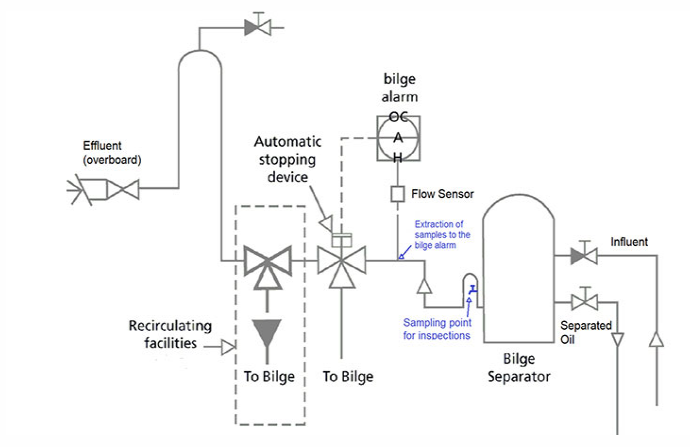The MEPC.107(49) requires a sampling point to be installed in a vertical section of the outlet pipe as close as possible to the 15 ppm bilge separator outlet. There have been several cases where ships have been detained for not complying with this requirement. This technical news summarizes this topic.
An oily water separator (OWS), bilge separator or oil filtering equipment is required by MARPOL Annex I, Regulation 14 to be installed on any ship above 400 GT. The unit shall be of a design approved by the administration and tested and installed according to guidelines in MEPC.107(49) as amended by MEPC.285(70).
There are two different sampling points mentioned in MEPC.107(49):
· For future inspections (paragraph 6.1.1)
· For the bilge alarm (paragraph 6.2.2)
Sampling points for future inspection (paragraph 6.1.1):
In MEPC 107(49) Chapter 6.1.1, Installation Requirements, it states that “For future inspection purposes on board ship, a sampling point should be provided in a vertical section of the water effluent piping as close as is practicable to the 15ppm bilge separator outlet.”
Sampling points for the bilge alarm (paragraph 6.2.2):
For the sampling point for extracting samples to the bilge alarm, paragraph 6.2.2 of MEPC.107(49) requires that “the arrangement on board ship for the extraction of samples from the 15 ppm Bilge Separator discharge line to the 15 ppm Bilge Alarm should give a truly representative sample of the effluent with an adequate pressure and flow”.
Hence, the requirement to install the sampling point in a vertical section of the effluent pipe applies to the sampling point for inspection only and does not apply to the sampling point for extracting samples to the bilge alarm. For the latter sampling point, the applicable installation requirements by the manufacturer of the oily water separator / bilge separator shall be followed to ensure a representative sample of the effluent with adequate pressure and flow.
Possible locations of these two sampling points are shown below as adapted from Figure 1 of MEPC.107(49). A loop may be installed at the bilge separator outlet to comply with the requirement stating that the sampling point for inspection purposes should be a vertical section of the effluent pipe.

The requirement to install the sampling point in a vertical section of the effluent pipe is, according to DNV’s understanding, to ensure that the sample is representative and homogenous. If the sampling point is installed in a horizontal section of the effluent pipe, there is a risk that the oil is floating at the top and will not be part of the sample.
For many OWSs, the effluent pipe is short before the 3-way valve and only a small part is vertical, so for many installations the sampling point is in the bend of the vertical section and extracts the sample from the vertical section. DNV considers this solution acceptable and in compliance with the regulations.
Recommendations
DNV recommends that ship owners or operators review the insights provided in this newsletter and ensure that the OWS sampling point is in a vertical position.
Source: https://www.dnv.com/
